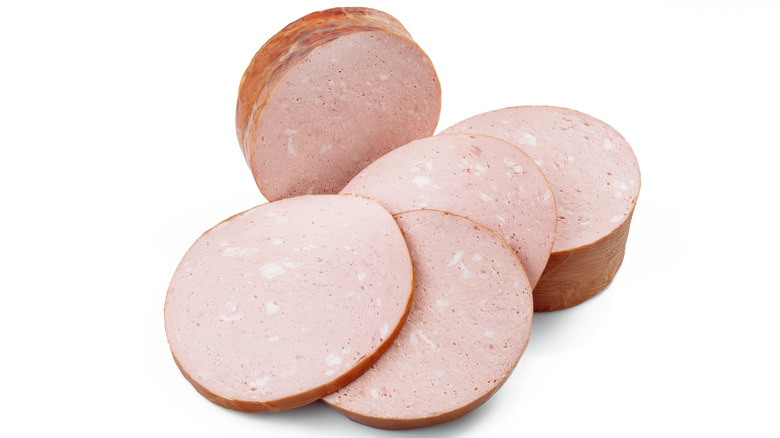Is Bologna Really Just A Flat Hot Dog?
There's a lot you can do with ground meat, whether it's making hamburgers, tacos, or meatloaf. But, if you think about it, aren't these dishes just the same thing in a different shape? Isn't meatloaf a hamburger that's been molded into the shape of a bread loaf? Isn't putting hot sauce on some Sloppy Joes the same as putting hot sauce on some taco meat? Perhaps it's the old mental trick of "different style, different taste," or the idea that if something looks different visually, you assume it's going to have a different taste.
While you could argue that there are obvious similarities in ground beef dishes, you'd probably have a harder time trying to make the same case for bologna and hot dogs. It's not very hard to see why, considering bologna and hot dogs not only look nothing alike but are prepared in disparate ways too. You slice bologna really thin and serve it raw on a sandwich or fry it up in a pan with some butter first. With a hot dog, you toss the tube-shaped piece of meat into a pot of water (or in some cases, the microwave) and then serve it on a bun with everything from mustard to chili to relish. At first glance, it's like comparing apples to oranges.
But we can not make assumptions based on cursory information alone. What exactly separates a hot dog from bologna, or are they more alike than you may think?
What's in hot dogs and bologna anyway?
To understand the differences and similarities between hot dogs and bologna, we must first understand precisely what's in these meat-based products. How are they made? Do they share any common ingredients? Are they prepared using the same cuts of meat?
Hot dogs, according to the National Hot Dog and Sausage Council, consist of a mixture of different meat trimmings such as beef, pork, and other poultry, water, beef stock, spices, sugar, and other additives like sodium nitrite and citric acid before being stuffed into a casing and smoked. Likewise, bologna is made with a combination of meats (or "trimmings" of beef, poultry, and pork), salt, and spices which is then piped into casings and smoked — very similar to how a hot dog is prepared. It would seem as if bologna and hot dogs share a very common ingredient list, but if that's the case, why make two different items from almost the same ingredients?
While hot dogs are commonly credited to German immigrants in the 1800s, who brought their sausages over from their home country to the United States, bologna's roots are entwined with Italian culture going back centuries. American bologna, as we know it, is an adoption of the Italian meat mortadella, which itself is a type of smoked sausage laced with cubes of pork fat.
Although both hot dogs and bologna share a similar ingredient list and preparation, they diverge in their cultural histories.
Hot dogs and bologna technically fall into the same category
"Whether you call it a frankfurter, hot dog, wiener, or bologna," says the United States Department of Agriculture, "it's a cooked sausage and a year-round favorite." If what the USDA says is to be believed, then that means that hot dogs and bologna are one and the same — or at least part of the same family.
This claim may not be too far off, considering that both the hot dog and bologna share a similar cooking process of being stuffed into a casing and then cooked. Of course, just because hot dogs and bologna are part of the same family tree doesn't mean they are easily interchangeable. Hot dogs are traditionally made to be long, skinny, and small, much like how ordinary sausage is produced. Bologna, on the other hand, is prepared to be large and short, meant for the express purpose of being cut into thin slices. Hot dogs and bologna may be the same style of sausage, but they are intended to be served in two completely unique ways.


